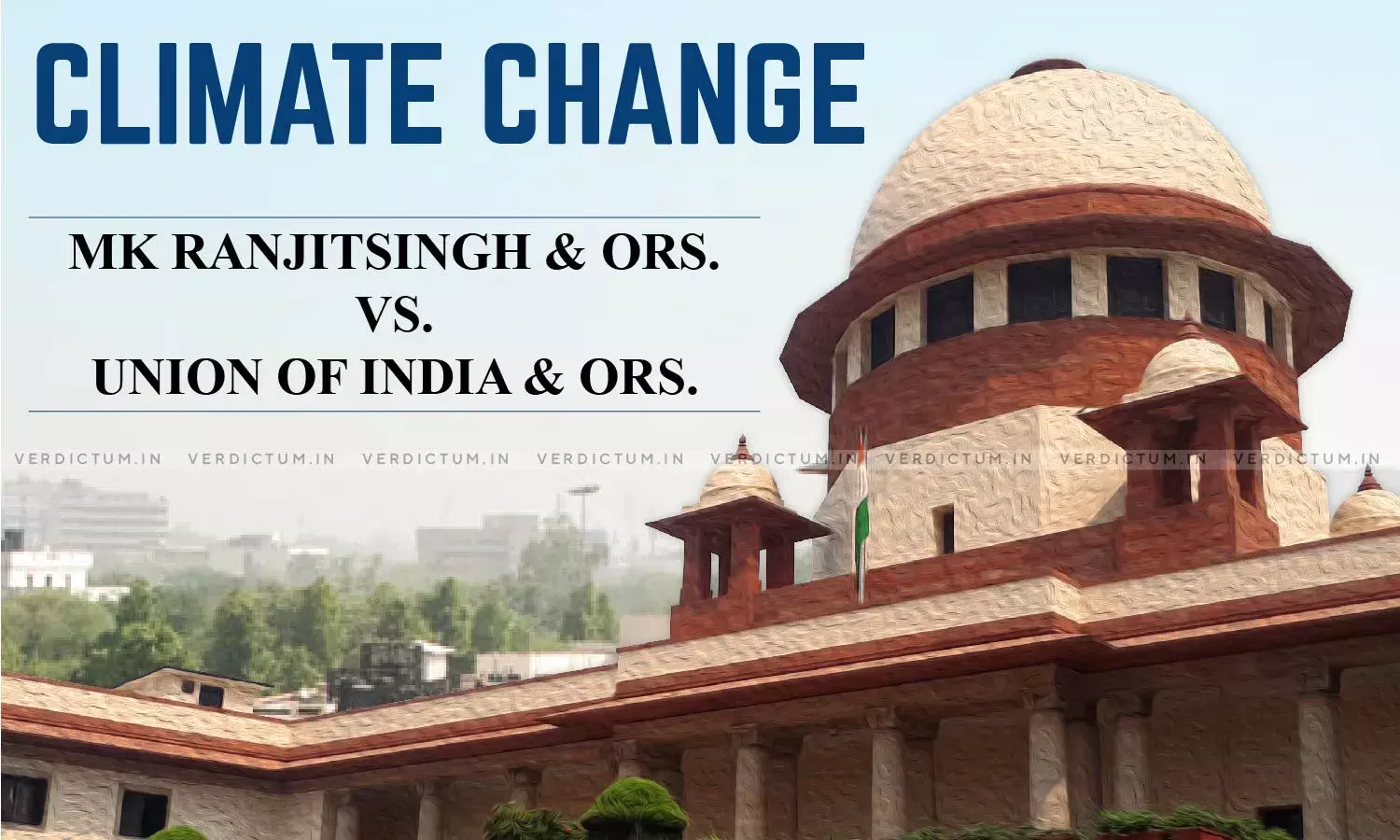MK Ranjitsinh vs. Union of India: Supreme Court Elaborates The Right To Be Free From Adverse Effects Of Climate Change
Recently, the Supreme Court in the matter of MKRanjitsinh and Ors. vs. Union of India and Ors. has recognized the right to be free from the adverse effects of climate change as a distinct right. The Court expanded the ambit of Articles 14 (equality before law and the equal protection of laws) and 21 (right to life and personal liberty) of the Constitution of India. In the present case, though directions were sought on various aspects for implementation of an emergency response plan for the protection and recovery of the Great Indian Bustard (hereinafter referred to as ‘GIB’), measures necessary for the protection of grasslands, sensitization amongst armed forces about the need for conservation of the GIB etc., however, the case majorly dealt with development of infrastructure in consonance with the conservation needs of wildlife and natural habitats.
A reference was made to an order of the court dated 19th April 2021, where it was observed that all low voltage powerlines existing in potential habitats of GIB are to be laid underground on a priority basis and the same was to be done in prospective cases. However, a general prohibition cannot be enforced and such implementation must be on a case-to-case basis.
The commissioning of transmission lines is a tedious process that takes about three to five years, including timelines for the augmentation of capacitors, reactors, transformers etc., and new transmission lines. Apart from several empirical and technical requirements, Section 34 of the Electricity Act of 2003 establishes grid standards. It requires each transmission licensee to adhere to the technical parameters of the maintenance and functioning of transmission lines as specified by the Authority, i.e. the Central Electricity Authority (CEA), under Section 70 of the Electricity Act of 2003. Section 73 of the Act outlines the CEA’s tasks and duties. It mandates the CEA to advise the government on energy policy, devise system improvement plans, and coordinate resource utilisation to ensure that everyone has access to dependable and inexpensive power. Importantly, the Authority is responsible for determining technical standards, safety criteria, and grid standards for the construction, operation, and maintenance of such infrastructure, as well as for the installation of electrical plants, electric lines, and grid connections. The required parameters have been envisaged under the Central Electricity Authority (Technical Standards for Construction of Electrical Plants and Electric Lines) Regulations, 2010 by the CEA.
Section 88 of the Regulation outlines the criteria for selecting the route of a transmission line. Firstly, it emphasizes avoiding routing through protected forests, national parks, and wildlife sanctuaries, with minimal tree cutting if unavoidable. It also stresses the importance of avoiding densely populated areas and large habitations. Further, it mandates compliance with statutory requirements and obtaining all necessary consents and approvals from relevant authorities, including those under various environmental and conservation acts. Moreover, Section 89(2)(c) of the regulation, clearances from trees and forest areas during the building of transmission lines must abide by the rules set out by the Ministry of Environment & Forests and the Forest Conservation Act.
In light of these provisions, it can be claimed that even though a committee of experts has been constituted to modify the earlier order that was issued on April 19, 2021—more precisely, the directive on the undergrounding of high- and low-voltage power lines—the ruling assured compliance with the necessary standards. It maintains that the construction of such infrastructure must prioritize the avoidance of protected forests, national parks, and wildlife sanctuaries. Owing to the intricacies brought about by elements like the GIB's natural habitats and the existence of solar transmission lines, it was necessary to gain a better understanding of how exactly the standards outlined in the Central Electricity Authority (Technical Standards for Construction of Electrical Plants and Electric Lines) Regulations, 2010 would respect citizens' rights to the environment.
This called for a more thorough comprehension of how these rules would transcend their technical requirements to take into account and protect citizen rights and environmental concerns. Thereby, the court has constituted an expert committee to assess the situation on various grounds of feasibility, the scope of overhead and underground transmission lines in potential GIB habitat areas and further identify reasonable measures to address the situation.
In the Indian legal framework, a single effective enactment that safeguards environment and climate change-related concerns does not exist, though several governmental policies, rules and regulations are operational however their enforceability doesn’t seem to be very efficient when it comes to addressing such concerns. However, the court's stance that the non-existence of a law does not translate to the non-existence of a right and its legal remedy is encouraging. Moreover, India has made significant commitments under international conventions in pursuit of global environment conservation goals. Starting with the Kyoto Protocol of 2005 obligating its parties to establish binding emission reduction targets. Furthermore, India has updated its first nationally determined contribution (NDC) for lowering greenhouse gas emissions as part of the Paris Agreement.
This revised commitment includes goals for shifting to renewable energy, supporting investments and financing related to climate change, and creating a national framework for technology dissemination. The original submission was made on October 2, 2015, with the updated targets extending until 2030. All these commitments necessitate India to undergo a transition phase from non-renewable to renewable energy sources, overhauling its energy supply needs. This transition necessitates significant infrastructural changes, potentially placing environmental rights and national environmental needs at a crossroads.
The Government of India released a position paper titled, ‘Climate Summit for Enhanced Action: A Financial Perspective from India,’ outlining India’s perspective on climate finance paper. The document emphasised that global climate action requires the delivery of the means of implementation, notably technology and timely and appropriate financing, characterised by "scope, scale, and speed." The paper argued that to a greater extent, the onus to safeguard global environmental concern and ensure compliance with emissions targets was to be attributed to the Western developed countries and thus demanded that the developed nations who had profited and developed at the perils of the environment and climate for over 100 years, should finance the developing nations to achieve their emission targets.
However, this approach couldn’t mean an exit from any form of responsibility towards climate conservation commitments. The governmental authorities are to a greater extent obligated to reasonably plan and allocate funds to infrastructure projects safeguarding environmental needs and protecting natural habitats.
Though the court recognized Article 48A of the Indian Constitution, providing for the states to endeavour to protect and improve the environment and to safeguard the forests and wildlife of the country, the importance of the invincible Articles 21 and 14 i.e. right to life and right to equality was emphasized which paved way for the court to eventually recognise “right to be free from the adverse effects of climate change” in the judgement. Admitting the fact, that rights of environmental safeguards are intertwined with various other rights of the citizens, it observed that “different constitutional rights must be carefully considered before a decision is reached in a particular case”. The vulnerability of Article 14 can easily emerge in such cases where indigenous communities in Andaman may fall into a precarious position when compared to the inhabitants of the northern plains due to rising sea levels, leading to risk to their constitutional guarantee of the right to equality.
An intriguing reference to the New Zealand case was made where a Kiribati citizen's asylum claim based on climate change impacts was rejected. However, courts ruled no immediate harm existed and Kiribati's government was deemed capable of protecting citizens. But it was also held that the decision would not rule out admissibility for future claims of a similar nature. The case of M.K. Ranjitsinh v. UOI stands out as a remarkable development in the Indian environmental law scenario. In a milieu where environmental laws are fragmented into various acts and where there exists a dearth of a single authoritative enactment safeguarding citizens’ rights for a safer environment, this case has recognised the much-needed "right to be of adverse effect of climate change" under Articles 21 and 14. This judgement will have landmark significance, translating this newly recognised right to be an important recource for future litigation concerning environmental safeguards and citizens’ right to a safer environment.
Global action against climate change has gained significant momentum worldwide, particularly with recent reports from the EU's climate service indicating that, for the first time, global warming has exceeded 1.5°C across an entire year. In this critical endeavour, India has been at the forefront, actively engaging in international forums and making numerous commitments while setting ambitious targets to combat climate change. Moreover, India has voiced the concerns of the global south, emphasizing that strategies to address climate change must be pursued without compromising on the developmental priorities of countries in the global south.
India’s commitments to sustainable development and measures against climate change on international forums obligate the protection of environmental rights for its citizens. Reduction in carbon emissions alone is not the solution but rather a transition to renewable energy would be a conclusive solution to the eminent global uncertainty of climate change. In this transition, it would be not an understatement that authorities are on a tightrope trying to balance the rights of the citizens and progressing with its developing needs. This judgment is poised to become a landmark case in Indian environmental law and paving the way for a new right to protection from adverse effects of climate change which in future litigations would serve as a definitive tool for addressing environmental concerns, with implications that extend to climate change mitigation and safeguarding citizens' rights to a healthier and safer environment.
Author is an Advocate Practising in the Supreme Court and the Delhi High Court and the co-author is a 2nd Year Law Student of Jamia Milia Islamia, New Delhi.
[The opinions expressed in this article are those of the authors. Verdictum does not assume any responsibility or liability for the contents of the article.]












